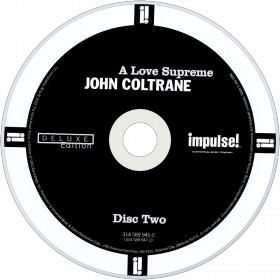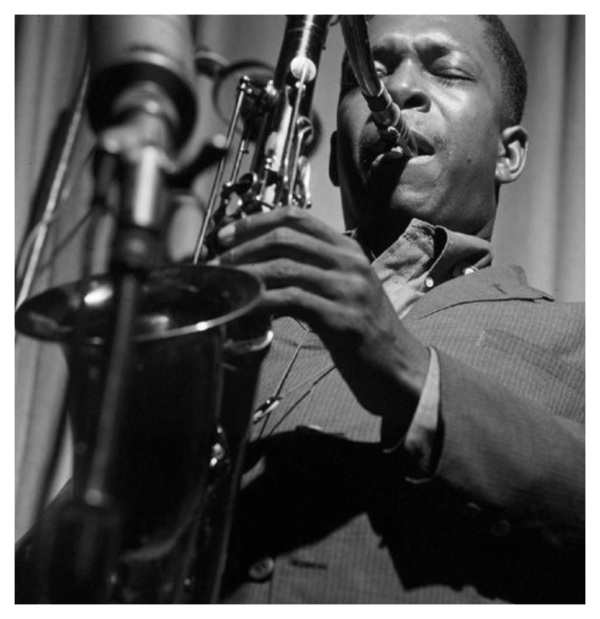COLTRANEFILM: Set against the social, political and cultural landscape of his times, the film will reveal the passions and demons that shaped Coltrane’s life, and explore why his music transcends the barriers of race, religion and age as it continues to inspire listeners around the world decades after his death. Utilizing never-before-seen Coltrane family home movies and audio recordings along with rare film and television appearances, Coltrane’s incredible story will be told by the people who know him best: his family, the musicians that worked with him, and the cultural icons who continue to draw inspiration from his fearless artistry and boundless creative vision.
“What is it about the music of John Coltrane that transcends all barriers of geography, race, religion and age? Who is this outside-the-box thinker whose boundary-shattering work continues to inspire people around the world’ Like any good mystery story, this film will peel back the layers of a compelling, emotional, passionate and dramatic life of demons and redemption to reveal the answers to these and other intriguing questions,” says writer and director John Scheinfeld. “We’re also offering people the chance to contribute to the film by sharing stories of how John Coltrane and his music have inspired them personally and professionally. All submissions to the film’s website will be reviewed and the best ones will be considered for the final cut.”
Born September 23rd, 1926 in Hamlet, North Carolina, John Coltrane’s first introduction to music came through his musician father. Growing up, Coltrane was obsessed with the records of Count Basie and Lester Young. At the age of 13, he picked up the saxophone and tried to imitate the sounds of his then idols Charlie Parker and Johnny Hodges. Thus began the career of one of the Twentieth Century’s most important and influential artists. Coltrane’s dramatic life story was cinematic in its scope¾from his early musical life playing alongside giants Dizzy Gillespie, Eddie Vinson and Jimmy Heath, to breakout performances with the Miles Davis Quintet on their classic recordings ‘Round About Midnight and Kind of Blue, to the historic partnership with Thelonious Monk and then finally to his astonishing solo career that gave the world such musical diamonds as Giant Steps, My Favorite Things, Impressions, Live at Birdland and 1965’s seminal A Love Supreme. “Trane” died in 1967 at the age of 40, an enigmatic, dominant figure whose massive influence on generations of artists has grown even stronger since his death. The film, targeted for theatrical release in late 2015 / early 2016. MORE
NPR: This week, we’ll see the 50th anniversary of a sacred day for many music fans. On December 9, 1964, the John Coltrane quartet recorded the album A Love Supreme. I call it a sacred day for music fans, not just jazz fans, because for people across musical boundaries and cultures, Santana, Bono, Joni Mitchell, Steve Rice, Bootsy Collins and Scott-Heron, hearing “A Love Supreme” was a revelation. “A Love Supreme” is Coltrane’s ultimate spiritual testament. The love supreme is God’s love. MORE
ALL MUSIC GUIDE: Easily one of the most important records ever made, John Coltrane’s A Love Supreme was his pinnacle studio outing that at once compiled all of his innovations from his past, spoke of his current deep spirituality, and also gave a glimpse into the next two and a half years (sadly, those would be his last). Recorded at the end of 1964, Trane’s classic quartet of Elvin Jones, McCoy Tyner, and Jimmy Garrison stepped into the studio and created one of the most thought-provoking, concise, and technically pleasing albums of their bountiful relationship (not to mention his best-selling to date). From the undulatory (and classic) bassline at the intro to the last breathy notes, Trane is at the peak  of his logical yet emotionally varied soloing while the rest of the group is remarkably in tune with Coltrane’s spiritual vibe. MORE
of his logical yet emotionally varied soloing while the rest of the group is remarkably in tune with Coltrane’s spiritual vibe. MORE
PREVIOUSLY: In its golden age, jazz was the radiator steam squealing out of the neon tenement soul of the postwar American night. Native son John Coltrane – who died 40 years ago today — was one those angel-headed hipsters tweaking the thermostat. You could bookend his sax mojo with the almost-pop My Favorite Things and the transcendental dissonance of Ascension. But Live at the Village Vanguard, Coltrane’s great white whale, swallows both of them whole. Recorded live over four nights in 1961, this box set captures Coltrane just as he was making the transition from mortal to immortal. After star-making collaborations with Miles and Monk, he stepped into the spotlight fronting a band that was for all intents and purposes the Led Zeppelin of jazz: Eric Dolphy, McCoy Tyner, Elvin Jones, Reggie Workman, Jimmy Garrison and Ahmed Abdul Malik. For four nights at the dawn of the ’60s, Coltrane and band scribbled out the same eight pieces–the modal raga of “India,” the holy-soul jellyroll of “Spiritual,” the zig-zag blues of “Chasin’ the Trane” and “Impressions,” the physical graffiti of “Brasilia” and “Greensleeves” and the midnight honk of “Miles’ Mode” and “Naima” –- telegraphing the decade’s looming radicalism. — JONATHAN VALANIA
Q&A: Talking Acid, Jazz & John Coltrane Stereo Blues* w/ Francis Davis, Dean Of Philly Jazz Critics

